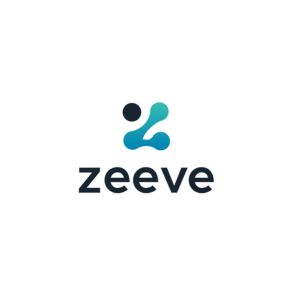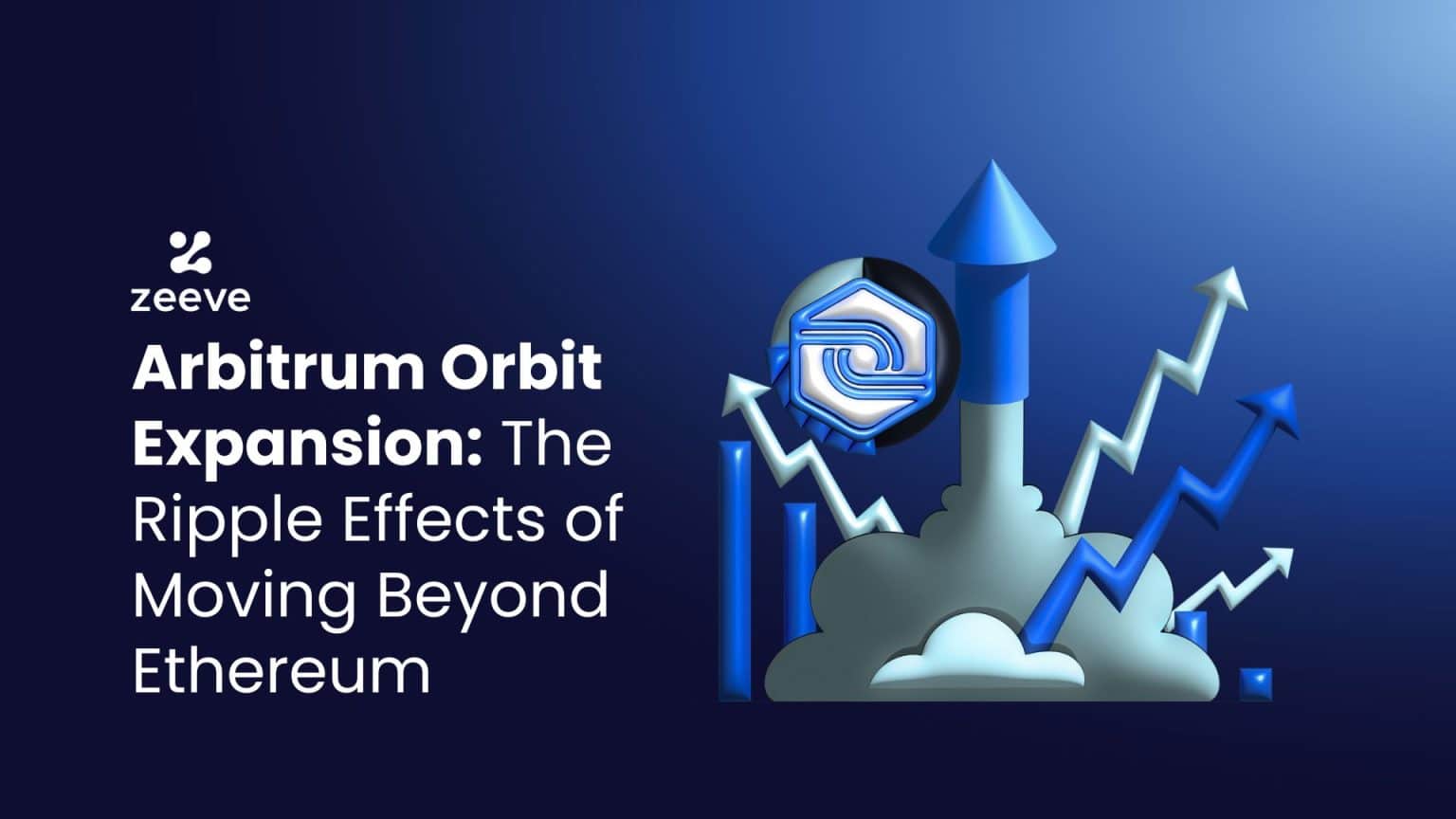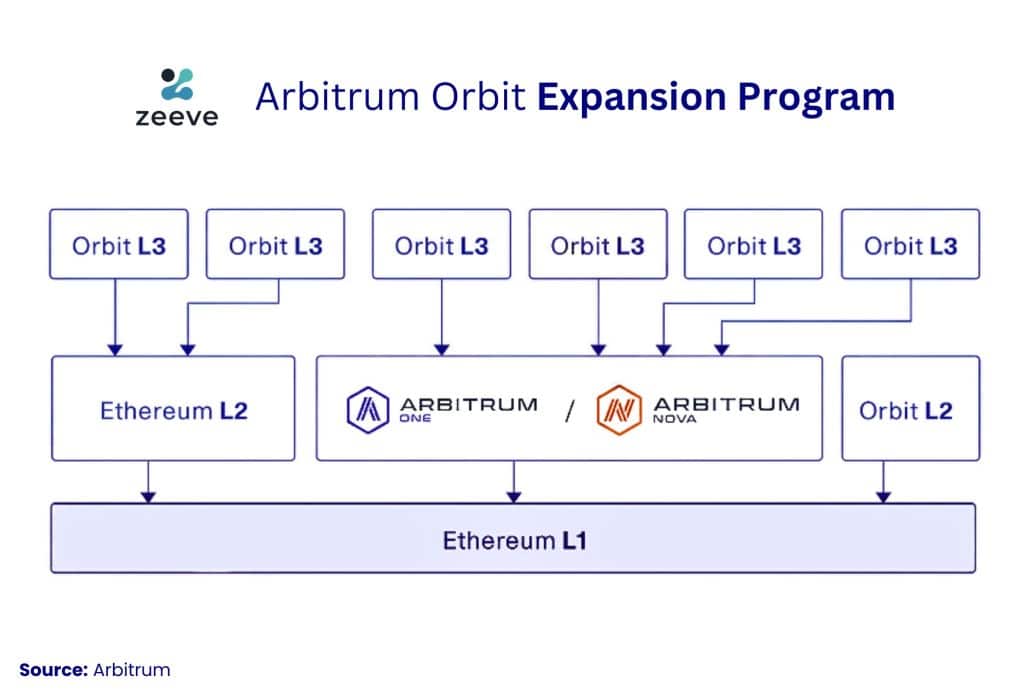Arbitrum Orbit Expansion: The Ripple Effects of Moving Beyond Ethereum
 Zeeve
Zeeve
Arbitrum Orbit serves as a highly matured and mainnet-aligned optimistic rollup framework, allowing web3 projects in various niches to build bespoke Layer2 and Layer3 chains with integrated features such as dedicated throughput, custom gas token, self-governance, and external data availability layer. Orbit ecosystem currently has around 56 chains (including testnet, mainnet, and chains that are announced) in top web3 categories, including DeFi, gaming, NFT, and Infra & tooling. Whereas the total number of Orbit chains was recorded at 20 in January 2024. This means, Arbitrum Orbit ecosystem has seen around 180% growth in a time span of 6 months. To take this growth to the next level, Arbitrum has now introduced the Arbitrum Expansion program.
In this article, we will explore the Arbitrum Orbit Expansion program to understand its ins and outs while highlighting the effects on Arbitrum after moving beyond Ethereum.
Run-through of Arbitrum Orbit Expansion Program
Arbitrum Orbit expansion program has been launched to expand Obit tech stack beyond Ethereum. The proposal allow 3rd party to fork Arbitrum’s codebase and modify it to their business-specific requirements with the ease of choose any non-Ethereum chain as their settlement layer. For example, developers can use Cosmos, Avalanche, or BNB Chains as their foundation or settlement layer. However, these chains must inherit security from Ethereum. These L2/L3 Orbit chains are truly modular with dedicated blockchain space, custom gas token, native account abstraction, alternative data availability layer choices, and other potential future services from the Arbitrum community.
Arbitrum Orbit expansion program provides an efficient process that replaces the traditional approach of launching Orbit chains, which are:
Launching a custom chain that chooses to settle on Arbitrum Nova or Arbitrum One in a permissionless way.
Requesting a software license from Arbitrum DAO through Arbitrum’s governance system.
Negotiating licensing terms with the Arbitrum Foundation.
Instead, developers interested in building their Orbit L2/L3 can now benefit from the self-service model to create their Layer2 or Layer3 chain that can use chains beyond Ethereum as settlement layer.

Main requirements to build with Arbitrum Orbit Expansion Program
Arbitrum has added two key requirements for projects building with the Arbitrum Orbit expansion program. First, projects must share a portion of their revenue with the Arbitrum ecosystem. Second, the deployment of Orbit chains should be on Ethereum or any non-Ethereum chains that use Ethereum’s security.
Initially, projects need to share 10% of their sequencer and MEV profit with Arbitrum DAO. After successful compliance checks, the percentage transferring to Arbitrum will be reduced to 8% and remaining 2% will go to Arbitrum Developer Guild. And, to ensure profits are automatically shared, Arbitrum requires projects to do essential configuration into their Orbit technology stack.
Speaking about deployment, Orbit chains can choose any chain outside Ethereum as their settlement layer or deploy on top of chains that derive Ethereum’s security, such as Aptos, Arbitrum, BNB Chain, Base, Bitcoin,Avalanche, Celo, and Cosmos.
Top Benefits of expanding Arbitrum Orbit’s Beyond Ethereum
Widespread adoption of Orbit chains:
The main reason for launching expansion programs is to foster widespread adoption of Arbitrum Orbit chains. Before the expansion program, Orbit chains had the option to either build an L2 on Arbitrum or an L3 on any Arbitrum Orbit L2. Now, By allowing projects to build L2/L3s on non–Ethereum and non-Arbitrum networks, Arbitrum is making the Orbit tech stack accessible across a variety of ecosystems such as Cosmos, Avalanche, Solana, Cardano, and Binance Smart Chain (BSC).
Growth in Arbitrum Revenue:
Arbitrum Orbit expansion will contribute significantly to the revenue. As discussed, L2s and L3s building on top of different chains are accountable for sharing a certain portion of their revenue with Arbitrum DAO as well as the Arbitrum Developer guild. Only the Layer3s that are settling on Arbitrum Nova or Arbitrum One will be exempted from this revenue-sharing system.
No hassle of migration:
Previously, a non-Arbitrum chain or a dApp seeking to build their custom L2/L3 had to undergo the complex process of migration. This required infrastructure optimization, upgrades in tooling & dev resources, chances in codebase, and more. Now, such projects can easily build Orbit L2/L3s on their existing ecosystem in a seamless, self-served manner. Under the program, Arbitrum will provide a complete suite of tools and essential services to the developers.
Endless customization & configuration:
Although chains using the Arbitrum expansion program will operate & manage outside Arbitrum, Arbitrum is offering the same level of support & customization benefits to all these L2/L3 chains. For example, projects can configure their chain to customize a depicted blockchain space, introduce custom tokens, add native account abstraction, use an off-chain DA layer, or other rollup-related services that offer modularity & flexibility.
Higher scalability for TPS
Many non-Ethereum chains are optimized for high TPS and lower fees as congestion is less on their network and meanwhile they leverage innovative scalability solutions. A good example for this are Cosmos and Avalanche. Both these networks offer parallel transactions processing through Zones and Subnets. Hence, Cosmos claim to offer 10,000 TPS while Avalanche at 4,500 TPS. This is far greater than Ethereum’s current TPS of 12-17 transactions.
Strengthing Ethereum’s position
Despite the vision of expanding Orbit chains beyond Ethereum, Arbitrum is strengthening Ethereum’s position because all the non-Ethereum and non-Arbitrum L2/L3 chains must settle on a chain that inherits security from Ethereum. This boosts Ethereum’s role as the foundational layer, allowing it to remain a leading ecosystem in the rapidly expanding blockchain ecosystem.
Key considerations:
Decentralization constraints:
Ethereum is committed to unparalleled decentralization, which is increased by 50% after its merge to proof-of-stake consensys. Now that the Arbitrum Orbit Expansion program encourages L2/L3s to include non-Ethereum chains as their settlement layer, it may impact the decentralization aspect, posing risks related to performance and security of the Orbit L2/L3s.
Governance fragmentation:
One of the spotlight of Arbitrum expansion program is ‘zero governance constraints’ which means Orbit L2/L3 developers will have full control over their network’s governance with no dependency on the shared governance. While this democraticizes the governance structure and allow teams to innovate endlessly, this same benefit can create decision-making challenges because a chain governed by Arbitrum DAO will have access to a community of top-notch decision-making community of users., developers, and stakeholders. Managing all this on your own can be a challenge.
Interoperabilty issues:
While expanding beyond Ethereum will drive endless growth to Arbitrum Orbit ecosystem, it will lead to problem of inter-chain interoperability since non-Ethereum chains struggle to communicate seamlessly across Ethereum chains. However, Arbitrum Foundation is aggressively researching and building a best-in-class interoperability solutions that will allow all the live Orbit L2/L3s to easily communicate to and leverage a unified Ethereum experience.
A Look into the future of Arbitrum Expansion Program
Orbit L2/L3s building under Arbitrum Orbit Expansion program will benefit from Arbitrum’s existing technical upgrades, including Bold and Stylus. Further, the expansion program will continue to introduce additional features and benefits like automatic smart contract upgrades and global pause system announced by Arbitrum security council. Hence, the Arbitrum Orbit Expansion program is considered as an evolving package that are available for projects that seek to innovate with Orbit technology stack.
If you are interested in launching an Orbit L2 or L3s under Arbitrum Orbit Expansion program, connect with us. The experts at Zeeve are ready to hear your project requirements and provide you a quick estimate accordingly. Also, you can use Zeeve RaaS platform to set up your mainnet-ready testnet for Orbit L2/L3s. Send us your queries or try Zeeve RaaS by yourself.
Subscribe to my newsletter
Read articles from Zeeve directly inside your inbox. Subscribe to the newsletter, and don't miss out.
Written by

Zeeve
Zeeve
Zeeve is an enterprise-grade low-code Blockchain Infrastructure-as-a-Service platform, compliant with ISO 27001, SOC2 Type II, and GDPR standards. We are the leading provider of Rollups-as-a-Service, dedicated node infrastructure, and hosted subgraphs. All the infrastructure managed by Zeeve includes 24x7 monitoring, Enterprise SLA, 99.9% uptime guarantee, and management dashboards to ensure a secure and scalable infrastructure. With support for all major Blockchains, 27,000+ platform users, and 40+ enterprise clients, Zeeve stands tall as the global go-to provider for Web3 infrastructure.
